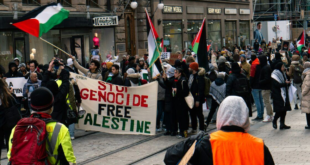BAGHDAD (AP) — An apparent suicide car bomber took aim at a US convoy carrying demolition experts on Sunday, collapsing a major highway overpass south of Baghdad and trapping American soldiers in the rubble.The vehicle detonated beside a support pillar, bringing down an Army checkpoint and a tent that had been on the collapsing span, dubbed “Checkpoint 20†by the US military.
The overpass, one of two crossing over Iraq’s main north-south highway in the region, appeared to be closed to all but military traffic at the time.
A US Army quick reaction force and the staff of Armour Group International, a private security firm that was in charge of the passing convoy, worked for some 45 minutes to pull trapped men from the rubble about six miles east of Mahmoudiya.
There appeared to be several casualties, including an Iraqi interpreter who was wounded, according to Donald Campbell, an official with the security firm who was at the scene.
The attack, which was witnessed by an Associated Press reporter and a photographer who were in the approaching convoy, occurred in the triangle of death, so called for frequent Sunni insurgent attacks.
On May 12, three US soldiers were captured in an ambush near Mahmoudiya that left five other soldiers, including an Iraqi dead.
An Al Qaeda front group the Islamic State of Iraq issued a video last week claiming the three missing troops had been killed, but the US military said it would not accept that and was continuing with its search.
Iraqi police said the overpass was a vital link across the highway for villagers in the area because the other spans have been taken over by US forces.
A police officer in nearby Iskandariyah, speaking on condition of anonymity because of security concerns, said a curfew had been imposed on vehicles and pedestrians after the attack on the span and earlier bombings of a mosque and a Sunni political party’s headquarters that caused some damage but no casualties.
In eastern Baghdad, a US helicopter fired flares on a crowd on a square, hours after clashes between American troops and Shiites that left at least five people dead. The military said the flares were part of an automatic self-defence system.
Fighting broke out in the predominantly Shiite Fidhiliyah area on the Baghdad’s outskirts late Friday after a US military convoy came under attack outside the local offices of Moqtada Sadr, the anti-American cleric whose Mahdi Army militia has recently stepped up attacks on American troops.
The US military said an American patrol called for air and ground support after it came under attack by small-arms fire and rocket-propelled grenades fired from the Sadr office. Spokesman Lt. Col. Christopher Garver said no Americans were killed or wounded, but he did not have immediate information on Iraqi casualties. “We’re still looking into the incident,†he said.
Sheikh Mohammad Hilfi, a Sadr representative from the office, said the clashes broke out after a raid on the office, which doubles as a mosque. The military did not confirm the raid.
He said seven people were killed and 21 wounded, while local police officials put the casualty figure at five killed and 19 wounded. The officials said those killed were Iraqis and included bystanders caught in the crossfire, while 16 other men were detained.
Hundreds of men chanted as they carried the wooden coffins draped in Iraqi flags of four people reportedly killed in the violence.
Associated Press Television video footage shot early Sunday showed a low-flying Apache helicopter firing flares as several hundred people, including teenagers and children, gathered around a devastated Humvee below.
Hilfi accused the Americans of using the helicopter flares to disperse the crowd so they could recover the charred Humvee.
But Garver said the flares were fired automatically as part of a self-defence system for the helicopters after several recent deadly attacks against the aircraft.
“Those are not launched by the crew,†he said. “When the helicopter receives a signal that it is being targeted by a radar, it launches those flares in self-defence against a perceived threat.â€
He said the flares, which are designed to divert heat-seeking missiles and other anti-aircraft weapons, usually burn out before they hit the ground but these were still burning because the helicopter was flying at low altitude.
Sadr’s Mahdi Army fought US forces for much of 2004. More recently, the US military has repeatedly blamed the group for the deaths of American soldiers killed by roadside bombs it says are provided by Iran.
A roadside bomb killed a US airman and wounded another Sunday in southern Iraq, the military said. The death raised to at least 3,504 members of the US military who have died since the Iraq war started in March 2003, according to an Associated Press count.
A suicide explosion on the outskirts of Tikrit at a police building killed 10 people, most of them officers, a police officer said, speaking on condition of anonymity because of security concerns.
The attacker detonated his payload after smashing into a blast wall, flattening a small reception building and damaging the main two-storey building 20 yards away, the officer said.
“It was a huge blast, my house was damaged,†said Khalaf Eidan, a 45-year-old shopkeeper who lives nearby. “I thank God that none of my children were hurt.â€
The blast was the deadliest of a series of attacks and other violence that killed at least 26 people, many targeting Iraqi police as gunmen continue to hammer the country’s shaky security forces. The terror campaign against Iraqi troops and police appears designed to blunt US progress in creating a stable local force so the Americans can go home.
 Eurasia Press & News
Eurasia Press & News

